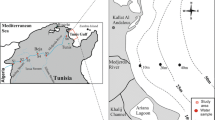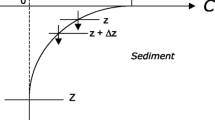Abstract
Purpose
The exchange of dissolved organic carbon (DOC) between sediment and water likely has an impact on aquatic DOC quantity and quality. Therefore, we developed a method to measure the flux of DOC between sediment and water.
Materials and methods
We constructed Plexiglas sediment core covers, which enable the stirring of the overlying water, continuous measuring of the oxygen concentration, adding and/or withdrawal of water, bubbling and microsensor measurements at the sediment-water interface. Sediment cores from two pre-dams of drinking water reservoirs were incubated in a set-up allowing the measurement of benthic fluxes of DOC and other solutes, including oxygen, dissolved nutrients and metals.
Results and discussion
Dissolved organic carbon fluxes were low and influenced by the redox conditions in the bottom water. We tested whether UV absorption (UV254) can be used as a fast method to monitor DOC changes in the core incubations. There was a good correlation between UV254 and DOC only at shallow, oxic sites. In anoxic waters, UV254 was strongly influenced by iron. The fluxes of DOC and other solutes, especially oxygen, differed by more than 1 order of magnitude. Thus, a two-step incubation, measuring first the fast fluxes followed by a 14-day incubation, is recommended. Sulfate reduction appeared to be the most important process of organic matter mineralisation under anoxic conditions, while aerobic respiration and, to a lesser extent, denitrification dominated under oxic conditions.
Conclusions
We present a set-up that allows measuring the flux of DOC as well as of other solutes between sediment and water. UV254 can be used as a proxy for DOC at oxic sites after establishing a site-specific calibration. Special care has to be taken to maintain redox conditions constant and to prevent oxygen depletion or contamination by atmospheric oxygen. The flux of DOC might be coupled to the reductive dissolution of iron minerals.





Similar content being viewed by others
References
Abell GCJ, Banks J, Ross DJ, Keane JP, Robert SS, Revill AT, Volkman JK (2011) Effects of estuarine sediment hypoxia on nitrogen fluxes and ammonia oxidizer gene transcription. FEMS Microbiol Ecol 75:111–122
Berg P, Risgaard-Petersen N, Rysgaard S (1998) Interpretation of measured concentration profiles in sediment pore water. Limnol Oceanogr 43:1500–1510
Beutel M, Burley N, Culmer K (2006) Quantifying the effects of water velocity and oxygen concentration on sediment oxygen demand (2006). Hydrol Sci Technol 22:15–28
Bondarenko A, Sani D, Ruello ML (2011) Design and calibration of an organic diffusive probe to extend the diffusion gradient technique to organic pollutants. Int J Env Res Public Health 8:3318–3332
Frenzel P, Thebrath B, Conrad R (1990) Oxidation of methane in the oxic surface layer of a deep lake sediment (Lake Constance). FEMS Microbiol Ecol 73:149–158
Gale PM, Reddy KR (1994) Carbon flux between sediment and water column of a shallow, subtropical, hypereutrophic lake. J Environ Qual 23:965–972
Glud RN (2008) Oxygen dynamics of marine sediments. Mar Biol Res 4:243–289
Hammond DE, Cummins KM, McManus J, Berelson WM, Smith G, Spagnoli F (2004) Methods for measuring benthic nutrient flux on the California margin: comparing shipboard core incubation to in situ lander results. Limnol Oceanogr Methods 2:146–159
Hargrave BT (1969) Similarity of oxygen uptake by benthic communities. Limnol Oceanogr 14:801–805
Higashino M, Gantzer CJ, Stefan HG (2004) Unsteady diffusional mass transfer at the sediment/water interface: theory and significance for SOD measurement. Water Res 38:1–12
Holmer M, Storkholm P (2001) Sulphate reduction and sulphur cycling in lake sediments: a review. Freshwat Biol 46:431–451
Hupfer M, Lewandowski J (2008) Oxygen controls the phosphorus release from lake sediments—a long-lasting paradigm in limnology. Int Rev Hydrobiol 93:415–432
Maloney KO, Morris DP, Moses CO, Osburn CL (2005) The role of iron and dissolved organic carbon in the absorption of ultraviolet radiation in humic lake water. Biogeochemistry 75:393–407
Matilainen A, Gjessing ET, Lahtinen T, Hed L, Bhatnagar A, Sillanpaa M (2011) An overview of the methods used in the characterisation of natural organic matter (NOM) in relation to drinking water treatment. Chemosphere 83:1431–1442
Müller B, Bryant LD, Matzinger A, Wüest A (2012) Hypolimnetic oxygen depletion in eutrophic lakes. Environ Sci Technol 46:9964–9971
Rinke K, Kuehn B, Bocaniov S, Wendt-Potthoff K, Büttner O, Tittel J, Schultze M, Herzsprung P, Rönicke H, Rink K, Rinke K, Dietze M, Matthes M, Paul L, Friese K (2013) Reservoirs as sentinels of catchments: the Rappbode Reservoir Observatory (Harz Mountains, Germany). Environ Earth Sci 69:523–536
Skoog A, Hall POJ, Hulth S, Paxeus N, vander Loeff MR, Westerlund S (1996) Early diagenetic production and sediment-water exchange of fluorescent dissolved organic matter in the coastal environment. Geochimica Et Cosmochimica Acta 60:3619–3629
Sommer S, Turk M, Kriwanek S, Pfannkuche O (2008) Gas exchange system for extended in situ benthic chamber flux measurements under controlled oxygen conditions: first application—sea bed methane emission measurements at Captain Arutyunov mud volcano. Limnol Oceanogr-Meth 6:23–33
Viollier E, Rabouille C, Apitz SE, Breuer E, Chaillou G, Dedieu K, Furukawa Y, Grenz C, Hall P, Janssen F, Morford JL, Poggiale JC, Roberts S, Shimmield T, Taillefert M, Tengberg A, Wenzhöfer F, Witte U (2003) Benthic biogeochemistry: state of the art technologies and guidelines for the future of in situ survey. J Exp Mar Biol Ecol 285(286):5–31
Weishaar JL, Aiken GR, Bergamaschi BA, Fram MS, Fujii R, Mopper K (2003) Evaluation of specific ultraviolet absorbance as an indicator of the chemical composition and reactivity of dissolved organic carbon. Environ Sci Technol 37:4702–4708
Wendt-Potthoff K, Kloß C, Schultze M, Koschorreck M (2014) Anaerobic metabolism of two hydro-morphological similar pre-dams under contrasting nutrient loading (Rappbode reservoir system, Germany). Int Rev Hydrobiol 99:350–362
Wobus A, Bleul C, Maassen S, Scheerer C, Schuppler M, Jacobs E, Roeske I (2003) Microbial diversity and functional characterization of sediments from reservoirs of different trophic state. FEMS Microbiol Ecol 46:331–347
Xiao YH, Sara-Aho T, Hartikainen H, Vahatalo AV (2013) Contribution of ferric iron to light absorption by chromophoric dissolved organic matter. Limnol Oceanogr 58:653–662
Zheng ZM, Lv J, Lu KH, Jin CH, Zhu JY, Liu XS (2011) The impact of snail (Bellamya aeruginosa) bioturbation on sediment characteristics and organic carbon fluxes in an eutrophic pond. Clean-Soil Air Water 39:566–571
Acknowledgments
This work was financially supported by the TALKO project (BMBF 02WT1290A). Thanks to Lionel Denis and Jo Banks for providing information about their set-ups. Thanks to the UFZ workshop for the excellent construction of the stirring heads. We thank Juliane Schmidt for her assistance in the laboratory and the UFZ GEWANA for sample analysis. Thanks to Dr. Wolf Von Tümpling for his advice on statistical analysis and to an anonymous reviewer whose suggestions significantly improved the manuscript.
Author information
Authors and Affiliations
Corresponding author
Additional information
Responsible editor: Carolyn Oldham
Rights and permissions
About this article
Cite this article
Dadi, T., Völkner, C. & Koschorreck, M. A sediment core incubation method to measure the flux of dissolved organic carbon between sediment and water. J Soils Sediments 15, 2350–2358 (2015). https://doi.org/10.1007/s11368-015-1213-4
Received:
Accepted:
Published:
Issue Date:
DOI: https://doi.org/10.1007/s11368-015-1213-4




